|
|
|
a4c0 | ||
| ... |
|
a0c0 | ||
| ... | Regulation | a0c0 | ||
| ... | Scope | a0c0 | ||
| ... | 1. Definitions | a0c0 | ||
| ... | 2. Application for approval | a0c0 | ||
| ... | 3. Markings | a0c0 | ||
| ... | 4. Approval | a0c0 | ||
| ... | 5. General specifications | a0c0 | ||
| ... | 6. Colour of light | a0c0 | ||
| ... | 7. Incidence of the light | a0c0 | ||
| ... | 8. Measuring procedure | a0c0 | ||
| ... | 9. Photometric characteristics | a0c0 | ||
| ... | 10. Conformity of production | a0c0 | ||
| ... | 11. Penalties for non-conformity of production | a0c0 | ||
| ... | 12. Production definitively discontinued | a0c0 | ||
| ... | 13. Transitional provisions | a0c0 | ||
| ... | 14. Names and addresses of Technical Services conducting approval tests, and of Type Approval Authorities | a0c0 | ||
| ... | Annexes | a0c0 | ||
| ... | 1 Arrangement of approval marks | a0c0 | ||
| ... | 2 Communication | a0c0 | ||
| ... | 3 Measurement points for test purposes | a0c0 | ||
| ... | 4 Minimum field of visibility of the surface to be illuminated | a0c0 | ||
| ... | 5 Photometric measurement of lamps equipped with several light sources | a0c0 | ||
| ... | 6 Minimum requirements for conformity of production control procedures | a0c0 | ||
| ... | 7 Minimum requirements for sampling by an inspector | a0c0 | ||
| ... |
|
a0c0 | ||
| ... |
This Regulation applies to rear registration plate lamps for vehicles of categories M, N, O, and T [1]. |
a0c0 | ||
|
|
|
a0c0 | ||
| 1. |
|
a0c0 | ||
| ... | For the purpose of this Regulation: | a0c0 | ||
| 1.1. |
"Rear registration plate lamp" means the device for the illumination of rear registration plates, hereinafter called "illuminating device", which illuminates the rear registration plate by reflection. For the approval of this device, the illumination of the space to be occupied by the plate is determined. |
a1c0 | ||
|
|
|
a1c0 | ||
|
|
|
a1c0 | ||
|
|
|
a1c0 | ||
|
|
|
a1c0 | ||
|
|
|
a1c0 | ||
| 1.2. | The definitions given in Regulation No. 48 and its series of amendments in force at the time of application for type approval shall apply to this Regulation. | a0c0 | ||
| 1.3. | "Rear registration plate lamps of different types" means lamps which differ in such essential respects as: | a0c0 | ||
| ... |
(a)The trade name or mark: |
a2c0 | ||
| ... | (b)The characteristics of the optical system (levels of intensity, light distribution angles, category of light source, light source module, etc.). | a0c0 | ||
| 1.4. |
References made in this Regulation to standard (étalon) filament lamp(s) and to Regulation No. 37 shall refer to Regulation No. 37 and its series of amendments in force at the time of application for type approval. |
a0c0 | ||
| ... |
References made in this Regulation to standard (étalon) LED light source(s) and to Regulation No. 128 shall refer to Regulation No. 128 and its series of amendments in force at the time of application for type approval. |
a0c0 | ||
| 2. |
|
a0c0 | ||
| ... |
The application for approval shall be submitted by the holder of the trade name or mark or by his duly accredited representative. |
a1c0 | ||
| ... | (a)Drawings (three copies) in sufficient detail to permit identification of the type and showing geometrically the position in which the illuminating device is to be fitted in relation to the space to be occupied by the registration plate, and the outlines of the area adequately illuminated. The drawings must show the position intended for the approval number in relation to the circle of the approval mark; | a0c0 | ||
| ... | (b)A brief technical description stating in particular, with the exception of lamps with non-replaceable light sources: | a0c0 | ||
| ... |
(i) The category or categories of filament lamp prescribed; this filament lamp category shall be one of those contained in Regulation No. 37 and its series of amendments in force at the time of application for type approval; and/or |
a0c0 | ||
| ... | (ii) The category or categories of LED light source(s) prescribed; this LED light source category shall be one of those contained in Regulation No. 128 and its series of amendments in force at the time of application for type approval.; and/or | a0c0 | ||
| ... | (iii) The light source module specific identification code[2]; | a0c0 | ||
| ... |
(c)Two samples, equipped with |
a2c0 | ||
| ... |
|
a2c0 | ||
| ... |
|
a2c0 | ||
|
|
|
a0c0 | ||
| 3. |
|
a0c0 | ||
| ... | Illuminating devices submitted for approval must bear: | a0c0 | ||
| 3.1. | The trade name or mark of the maker or manufacturer of the illuminating device; | a0c0 | ||
| 3.2. | A space of sufficient size for the approval mark; this space shall be shown in the drawings mentioned in paragraph 2. (a) above. | a0c0 | ||
| 3.3. |
In the case of lamps with non-replaceable light sources or light source module(s), the marking of the rated voltage or range of voltage |
a2c0 | ||
| 3.4. | With the exception of lamps with non-replaceable light sources it must bear a clearly legible and indelible marking indicating: | a0c0 | ||
| ... | (a)The category or categories of light source(s) prescribed; and/or | a0c0 | ||
| ... | (b)The light source module specific identification code. | a0c0 | ||
| 3.5. | In the case of lamps with light source module(s), the light source module(s) shall bear: | a0c0 | ||
| 3.5.1. | The trade name or mark of the applicant; this marking must be clearly legible and indelible; | a0c0 | ||
| 3.5.2. |
The specific identification code of the module; this marking must be clearly legible and indelible. This specific identification code shall comprise the starting letters "MD" for "MODULE" followed by the approval marking without the circle as prescribed in paragraph 4.4.1. below and, in the case of several non-identical light source modules are used, followed by additional symbols or characters; this specific identification code shall be shown in the drawings mentioned in paragraph 2. (a) above. |
a0c0 | ||
| ... | The approval marking does not have to be the same as the one on the lamp in which the module is used, but both markings shall be from the same applicant. | a0c0 | ||
| 3.5.3. |
The marking of the rated voltage |
a2c0 | ||
| 4. |
|
a0c0 | ||
| 4.1. | If the two samples of a type of illuminating device submitted in accordance with paragraph 2. above satisfy the provisions of this Regulation, approval shall be granted. | a0c0 | ||
| 4.2. | An approval number shall be assigned to each type approved. Its first two digits (at present 00 for the Regulation in its original form) shall indicate the series of amendments incorporating the most recent major technical amendments made to the Regulation at the time of issue of the approval. The same Contracting Party may not assign this number to another type of device covered by this Regulation, except in the case of an extension of the approval to a device differing only in the colour of the light emitted. | a0c0 | ||
| 4.3. | Notice of approval or of extension or refusal of approval of a type of illuminating device pursuant to this Regulation shall be communicated to the Parties to the 1958 Agreement applying this Regulation, by means of a form conforming to the model in Annex 2 to this Regulation. | a0c0 | ||
| 4.4. |
Every illuminating device conforming to a type approved under this Regulation shall, in addition to the markings referred to in paragraphs 3. (a) and (c) above, bear an international approval mark in conformity with Annex 1, consisting of: |
a0c0 | ||
| 4.4.1. | A circle surrounding the letter "E" followed by a number identifying the country which has granted approval[3]; | a0c0 | ||
| 4.4.2. | An approval number, in the vicinity of the circle; | a0c0 | ||
| 4.4.3. | The following additional symbol: the letter "L"; | a0c0 | ||
| 4.4.4. |
The first two digits of the approval number which indicate the most recent series of amendments to this Regulation may be placed in the vicinity of the additional symbol L. |
a0c0 | ||
|
|
|
a0c0 | ||
| 4.5. | The mark and symbols referred to in paragraphs 4.4.1., 4.4.2. and 4.4.3. shall be indelible and shall be clearly legible even when the illuminating device is mounted on the vehicle. | a0c0 | ||
| 4.6. | When two or more lamps are part of the same unit of grouped, combined or reciprocally incorporated lamps, approval is granted only if each of these lamps satisfies the requirements of this Regulation or of another Regulation. Lamps not satisfying any one of those Regulations shall not be part of such a unit of grouped, combined or reciprocally incorporated lamps. | a0c0 | ||
| 4.6.1. | Where grouped, combined or reciprocally incorporated lamps comply with the requirements of several Regulations, a single international approval mark may be applied, consisting of a circle surrounding the letter "E" followed by the distinguishing number of the country which has granted the approval, an approval number and, if necessary, the required arrow. This approval mark may be placed anywhere on the grouped, combined or reciprocally incorporated lamps provided that: | a0c0 | ||
| 4.6.1.1. | It is visible after their installation; | a0c0 | ||
| 4.6.1.2. | No part of the grouped, combined or reciprocally incorporated lamps that transmits light can be removed without at the same time removing the approval mark. | a0c0 | ||
| 4.6.2. | The identification symbol for each lamp appropriate to each Regulation under which approval has been granted, together with the corresponding series of amendments incorporating the most recent major technical amendments to the Regulation at the time of issue of the approval, shall be marked: | a0c0 | ||
| 4.6.2.1. | Either on the appropriate light-emitting surface; | a0c0 | ||
| 4.6.2.2. |
Or in a group, in such a way that each lamp of the grouped, combined or reciprocally incorporated lamps may be clearly identified (see three possible examples in Annex 1). |
a0c0 | ||
| 4.6.3. | The size of the components of a single approval mark shall not be less than the minimum size required for the smallest of the individual marks by a Regulation under which approval has been granted. | a0c0 | ||
| 4.6.4. | An approval number shall be assigned to each type approved. The same Contracting Party may not assign the same number to another type of grouped, combined or reciprocally incorporated lamps covered by this Regulation. | a0c0 | ||
| 4.6.5. | The approval marking shall be clearly legible and indelible. It may be placed on an inner or outer part (transparent or not) of the device which cannot be separated from the transparent part of the device emitting the light. In any case the marking shall be visible when the device is fitted on the vehicle or when a movable part such as the hood or boot lid or a door is opened. | a0c0 | ||
| 4.7. |
Annex 1 gives examples of arrangements of approval marks for a single lamp (Figure 1) and for grouped, combined or reciprocally incorporated lamps (Figure 2) with all the additional symbols referred to above. |
a0c0 | ||
| 5. |
|
a0c0 | ||
| ... |
The requirements pertinent to each device and to the category/ies of vehicle on which the device is intended to be installed shall be applied, where its verification at the moment of device type approval is feasible. Each device shall satisfy the provisions of paragraph 9[4]. |
a2c0 | ||
|
|
|
a0c0 | ||
| 5.1. | The devices for the illumination of rear registration plates shall be so constructed that the whole surface of the plate will be visible within the angles given in Annex 4. | a0c0 | ||
| 5.2. | All measurements shall be made with the standard uncoloured or coloured light source of the category prescribed by the manufacturer, supplied with the voltage: | a0c0 | ||
| ... | (a)In the case of filament lamp(s), that is necessary to produce the reference luminous flux required for that category of filament lamp; | a0c0 | ||
| ... |
(b)In the case of LED light source(s) of 6.75 V, 13.5 V or 28.0 V, the luminous flux value produced shall be corrected. The correction factor is the ratio between the objective luminous flux and the value of the luminous flux found at the voltage applied. |
a0c0 | ||
| ... | All measurements on the devices with non-replaceable light sources shall be made at 6.75 V, 13.5 V or 28.0 V respectively. | a0c0 | ||
| 5.3 | In the case of light sources supplied by a special power supply, the above test voltages shall be applied to the input terminals of that power supply. The test laboratory may require from manufacturer the special power supply needed to supply the light sources. | a0c0 | ||
| 5.4. |
For any rear registration plate illuminating device, except those equipped with filament lamp(s), the luminance values measured after one minute and after 30 minutes of operation shall comply with the minimum requirements. |
a0c0 | ||
| ... | The luminance distribution after one minute of operation can be calculated by applying at each test point the ratio of luminance values measured in one point after one minute and after 30 minutes of operation. | a0c0 | ||
| 5.5. | In the case of light source modules, it shall be checked that: | a0c0 | ||
| 5.5.1. | The design of the light source module(s) shall be such as: | a0c0 | ||
| ... | (a)That each light source module can only be fitted in no other position than the designated and correct one and can only be removed with the use of tool(s); | a0c0 | ||
| ... | (b)If there are more than one light source module used in the housing for a device, light source modules having different characteristics cannot be interchanged within the same lamp housing. | a0c0 | ||
| 5.5.2. | The light source module(s) shall be tamperproof. | a0c0 | ||
| 5.5.3. | A light source module shall be so designed that regardless of the use of tool(s), it shall not be mechanically interchangeable with any replaceable approved light source. | a0c0 | ||
| 5.6. | In the case of replaceable light source(s): | a0c0 | ||
| 5.6.1. |
|
a3c0 | ||
| 5.6.2. | The design of the device shall be such that the light source cannot be fixed in any other position but the correct one. | a0c0 | ||
| 5.6.3. |
The light source holder shall conform to the characteristics given in IEC Publication 60061. The holder data sheet relevant to the category of light source used, applies. |
a0c0 | ||
|
|
|
a2c0 | ||
| 6. |
|
a0c0 | ||
| ... | The light of the lamp used in the illuminating device must be sufficiently colourless not to cause any appreciable change in the colour of the registration plate. | a0c0 | ||
| 7. |
|
a0c0 | ||
| ... |
The manufacturer of the illuminating device shall specify one or more or a field of positions in which the device is to be fitted in relation to the space for the registration plate; when the lamp is placed in the position (s) specified by the manufacturer the angle of incidence of the light on the surface of the plate shall not exceed 82° at any point of the surface to be illuminated, this angle being measured from the extremity of the device's illuminating area which is furthest from the surface of the plate. If there is more than one illuminating device, the foregoing requirement shall apply only to that part of the plate intended to be illuminated by the device concerned. |
a0c0 | ||
| ... | When the device has one outer edge of the illuminating surface that is parallel to the surface of the registration plate, the extremity of the illuminating surface of the device which is furthest from the surface of the plate is the middle point of the edge of the illuminating surface, which is parallel to the plate and is furthest from the surface of the plate. | a0c0 | ||
| ... | The device must be so designed that no light is emitted directly towards the rear, with the exception of red light if the device is combined or grouped with a rear lamp. | a0c0 | ||
| 8. |
|
a0c0 | ||
| ... | Luminance measurements shall be made on a diffuse colourless surface with known diffuse reflection factor[4]. The diffuse colourless surface shall have the dimensions of the registration plate or the dimension exceeding one measuring point. Its centre shall be placed in the centre of the positions of the measuring points. | a0c0 | ||
|
|
|
a0c0 | ||
| ... | This diffuse colourless surface(s) shall be placed in the position normally occupied by the registration plate and 2 mm in front of its holder. | a0c0 | ||
| ... |
Luminance measurements shall be made perpendicularly to the surface of the diffuse colourless surface with the tolerance of 5° in each direction at the points shown in Annex 3 to this Regulation, each point representing a circular area of 25 mm in diameter. The measured luminance shall be corrected for the diffuse reflection factor 1.0. |
a0c0 | ||
| 9. |
|
a0c0 | ||
| ... | At each of the points of measurement shown in Annex 3, the luminance B shall be at least equal to 2.5 cd/m2. | a0c0 | ||
| ... |
The gradient of the luminance between the values B1 and B2, measured at any two points 1 and 2 selected from among those mentioned above, shall not exceed 2xBo/cm, Bo being the minimum luminance measured at the various points, that is to say: |
a0c0 | ||
| ... |

|
a0c0 | ||
| 10. |
|
a0c0 | ||
| ... | The conformity of production procedures shall comply with those set out in the Agreement, Appendix 2 (E/ECE/324-E/ECE/TRANS/505/Rev.2), with the following requirements: | a0c0 | ||
| 10.1. |
Devices for the illumination of rear registration plates (henceforth called devices) |
a2c0 | ||
|
|
The minimum requirements for conformity of production control procedures set forth in Annex 6 to this Regulation shall be complied with. | a2c0 | ||
|
|
The minimum requirements for sampling by an inspector set forth in Annex 7 to this Regulation shall be complied with. | a2c0 | ||
|
|
The Authority which has granted type approval may at any time verify the conformity control methods applied in each production facility. The normal frequency of these verifications shall be once every two years. | a2c0 | ||
|
|
|
a2c0 | ||
| 11. |
|
a0c0 | ||
| 11.1. | The approval granted in respect of an illuminating device pursuant to this Regulation may be withdrawn if the requirements laid down above are not complied with. | a0c0 | ||
| 11.2. |
If a Party to the Agreement which applies this Regulation withdraws an approval it has previously granted, it shall forthwith notify the other Contracting Parties applying this Regulation thereof by means of a communication form conforming to the model in Annex 2 to this Regulation. |
a0c0 | ||
| 12. |
|
a0c0 | ||
| ... |
If the holder of the approval completely ceases to manufacture an illuminating device under this Regulation, he shall inform thereof the Authority which granted the approval. Upon receiving the relevant communication that Authority shall inform the other Parties to the Agreement which apply this Regulation thereof by means of a communication form conforming to the model in Annex 2 to this Regulation. |
a0c0 | ||
| 13. |
|
a0c0 | ||
|
|
|
a4c0 | ||
|
|
|
a4c0 | ||
|
|
|
a4c0 | ||
|
|
|
a4c0 | ||
|
|
|
a4c0 | ||
|
|
|
a4c0 | ||
|
|
|
a4c0 | ||
|
|
|
a4c0 | ||
|
|
|
a4c0 | ||
|
|
|
a4c0 | ||
|
|
|
a4c0 | ||
|
|
|
a4c0 | ||
|
|
|
a4c0 | ||
|
|
|
a4c0 | ||
|
|
|
a4c0 | ||
| 14. |
|
a0c0 | ||
| ... | The Parties to the Agreement which apply this Regulation shall communicate to the Secretariat of the United Nations the names and addresses of the Technical Services conducting approval tests and of the Type Approval Authorities which grant approval and to which forms certifying approval or refusal or withdrawal or approval, issued in other countries, are to be sent. | a0c0 | ||
| A1 |
|
a0c0 | ||
| A1 |
|
a0c0 | ||
| A1 |
Figure 1 |
a0c0 | ||
| A1 | (Marking for single lamps) | a0c0 | ||
| A1 | Model A | a0c0 | ||
| A1 |
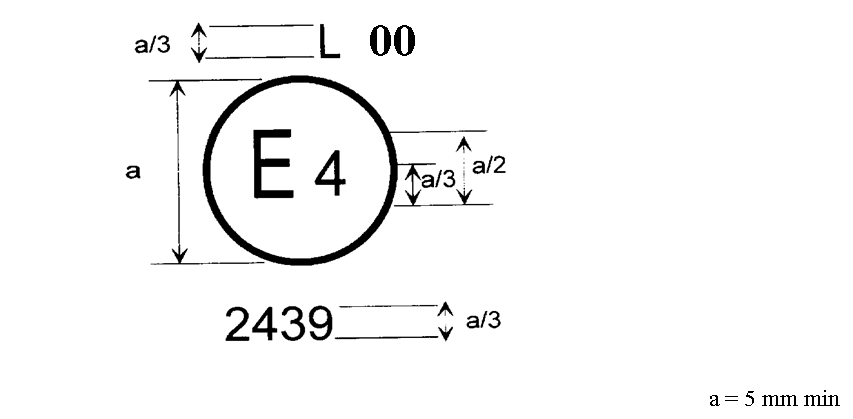
|
a0c0 | ||
| A1 |
The device bearing the approval mark shown above is a device for the illumination of a vehicle's rear registration plate (L) approved in the Netherlands (E4) pursuant to Regulation No. 4 under approval number 2439. The approval number indicates that the approval was granted in accordance with the requirements of Regulation No. 4 in its original form or as amended by the respective supplements to the Regulation in its original form, as the case may be. |
a0c0 | ||
| A1 | Figure 2 | a0c0 | ||
| A1 | Simplified marking for grouped, combined or reciprocally incorporated lamps | a0c0 | ||
| A1 | (The vertical and horizontal lines schematize the shape of the light-signalling device. These are not part of the approval mark). | a0c0 | ||
| A1 |

|
a0c0 | ||
| A1 |
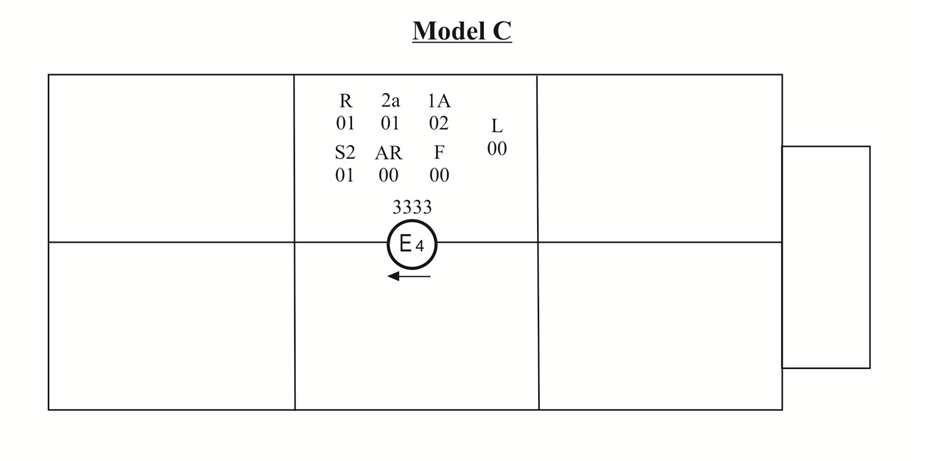
|
a0c0 | ||
| A1 |
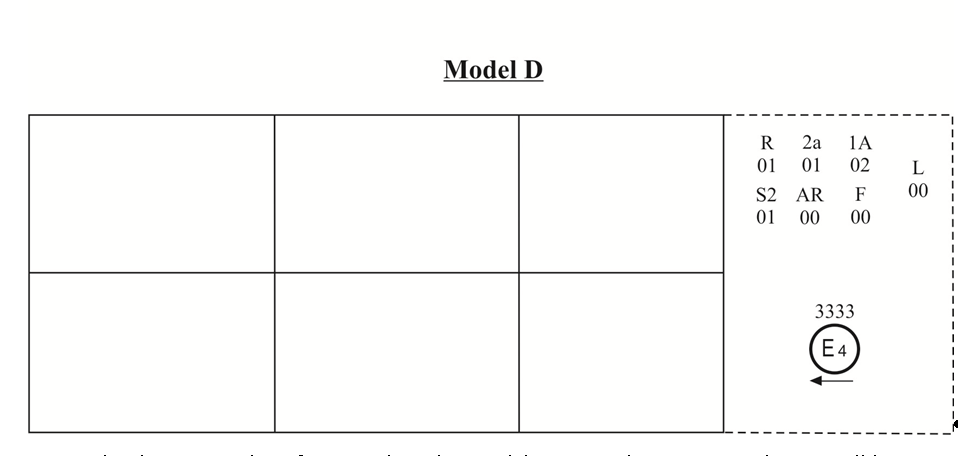
|
a0c0 | ||
| A1 | Note: The three examples of approval marks, models B, C and D represent three possible variants of the marking of a lighting device when two or more lamps are part of the same unit of grouped, combined or reciprocally incorporated lamps. This approval mark shows that the device was approved in the Netherlands (E4) under approval number 3333 and comprising: | a0c0 | ||
| A1 | A retro reflector of class IA approved in accordance with the 02 series of amendments to Regulation No. 3; | a0c0 | ||
| A1 |
A rear direction indicator of category 2a approved in accordance with the 01 series of amendments to Regulation No. 6; |
a0c0 | ||
| A1 | A red rear position lamp (R) approved in accordance with the 01 series of amendments to Regulation 7; | a0c0 | ||
| A1 | A rear fog lamp (F) approved in accordance with Regulation No. 38 in its original form; | a0c0 | ||
| A1 | A reversing lamp (AR) approved in accordance with Regulation No. 23 in its original form; | a0c0 | ||
| A1 | A stop lamp with two levels of illumination (S2) approved in accordance with the 01 series of amendments to Regulation No. 7; | a0c0 | ||
| A1 | A rear registration plate illuminating device (L) approved in accordance with Regulation No. 4 in its original form. | a0c0 | ||
| A1 | Figure 3 | a0c0 | ||
| A1 | Light source modules | a0c0 | ||
| A1 | Model E | a0c0 | ||
| A1 |
 |
a0c0 | ||
| A1 | The light source module bearing the identification code shown above has been approved together with a lamp approved in Italy (E3) under approval number 17325. | a0c0 | ||
| A2 |
|
a0c0 | ||
| A2 |
|
a0c0 | ||
| A2 | (Maximum format: A4 (210 x 297 mm)) | a0c0 | ||
| A2 |
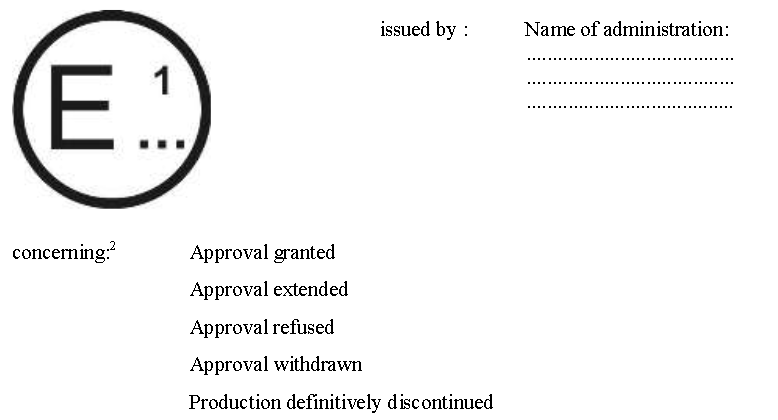
|
a0c0 | ||
| A2 | of a type of device for the illumination of rear registration plates of motor vehicles (except motor cycles) and their trailers pursuant to Regulation No. 4 | a0c0 | ||
| A2 |
|
a0c0 | ||
| A2 1. | Trade name or mark of the device: | a0c0 | ||
| A2 2. | Manufacturer's name for the type of device: | a0c0 | ||
| A2 3. | Manufacturer's name and address: | a0c0 | ||
| A2 4. | If applicable, name and address of manufacturer's representative | a0c0 | ||
| A2 5. | Submitted for approval on: | a0c0 | ||
| A2 6. | Technical Service responsible for conducting approval tests: | a0c0 | ||
| A2 7. | Date of report issued by that Service: | a0c0 | ||
| A2 8. | Number of report issued by that Service: | a0c0 | ||
| A2 9. | Concise description[3]: | a0c0 | ||
| A2 | Device for illuminating: | a0c0 | ||
| A2 |
|
a1c0 | ||
| A2 | Number and category (ies) of light source(s): | a0c0 | ||
| A2 | Light source module: Yes/No[2] | a0c0 | ||
| A2 | Light source module specific identification code: | a0c0 | ||
| A2 |
Geometrical conditions of installation (position(s) and inclination(s) of the device in relation to the space to be occupied by the registration plate and/or different inclinations of this space): |
a0c0 | ||
| A2 10. | Position of the approval mark: | a0c0 | ||
| A2 11. | Reason(s) for extension (if applicable): | a0c0 | ||
| A2 12. | Approval granted/extended/refused/withdrawn [2]: | a0c0 | ||
| A2 13. | Place: | a0c0 | ||
| A2 14. | Date: | a0c0 | ||
| A2 15. | Signature: | a0c0 | ||
| A2 16. | The list of documents deposited with the Type Approval Authority which has granted approval is annexed to this communication and may be obtained on request. | a0c0 | ||
|
A2 |
|
a0c0 | ||
|
A2 |
|
a0c0 | ||
|
A2 |
|
a0c0 | ||
| A3 |
|
a0c0 | ||
| A3 |
|
a0c0 | ||
| A3 |
|
a1c0 | ||
| A3 |
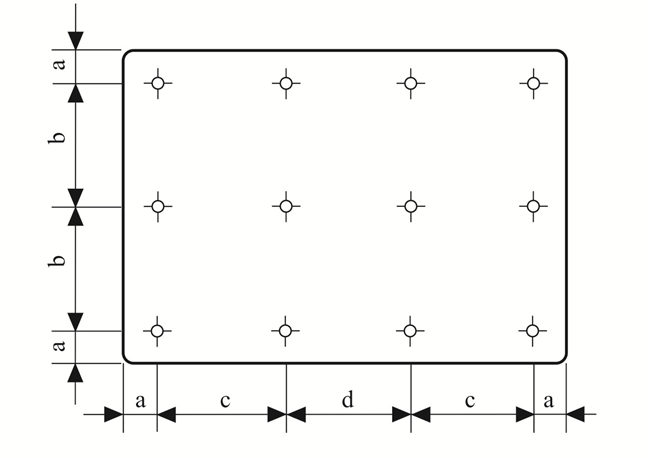
|
a0c0 | ||
| A3 |
|
a1c0 | ||
| A3 |
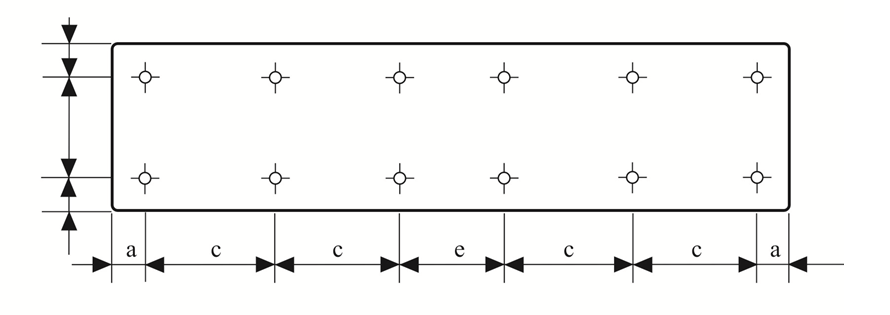
|
a0c0 | ||
| A3 |
|
a1c0 | ||
| A3 |

|
a1c0 | ||
| A3 |
|
a1c0 | ||
| A3 |

|
a1c0 | ||
| A3 |
|
a1c0 | ||
| A3 |
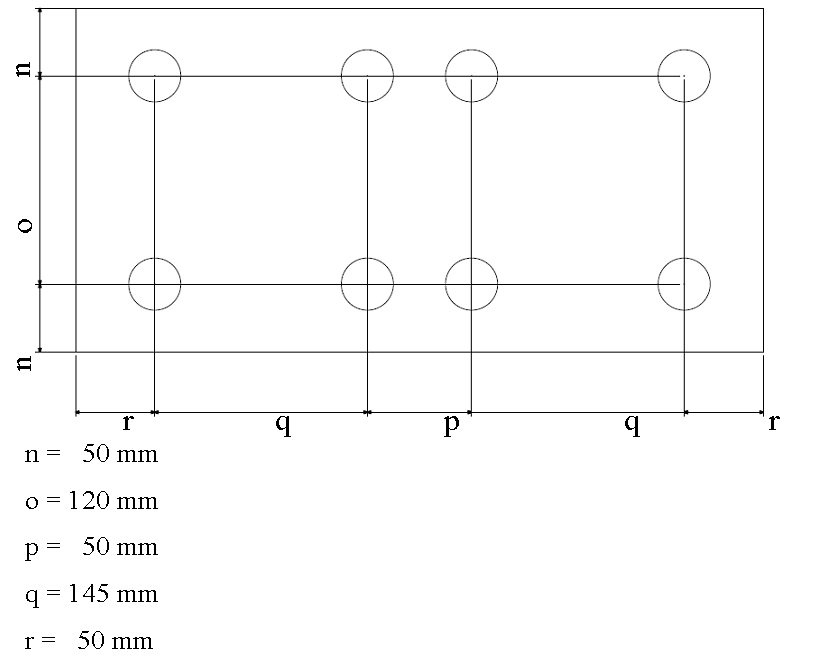
|
a1c0 | ||
| A3 |
Note: In the case of devices for illuminating two or all of the plates, the measurement points used are obtained by combining the corresponding drawings above in accordance with the outline indicated by the make or manufacturer; however, if two measurement points are less than 30 mm apart, only one shall be used. |
a0c0 | ||
| A4 |
|
a0c0 | ||
| A4 |
|
a0c0 | ||
| A4 |
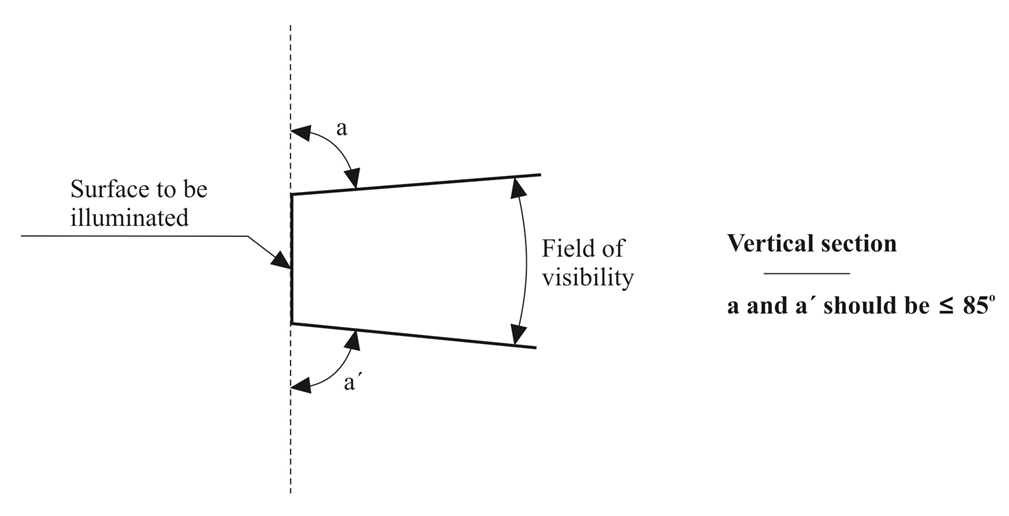
|
a0c0 | ||
| A4 |

|
a0c1 | ||
| A4 1. | The field-of-visibility angles shown above relate only to the relative positions of the illuminating device and the space for the registration plate. | a0c0 | ||
| A4 2. | The field of visibility of the registration plate when mounted on the vehicle remains subject to the relevant national regulations. | a0c0 | ||
| A4 3. | The angles shown take account of the partial occultation caused by the illuminating device. They must be adhered to in the directions in which there is most occultation. The illuminating devices must be such as to reduce the areas partly occulted to the minimum strictly necessary. | a0c0 | ||
| A5 |
|
a0c0 | ||
| A5 | Photometric measurement of lamps equipped with several light sources | a0c0 | ||
| A5 1. | The photometric performance shall be checked: | a0c0 | ||
| A5 1.1. | For non-replaceable light sources (filament lamps and other): | a0c0 | ||
| A5 |
With the light sources present in the lamp, in accordance with paragraph 5.2.1. of this Regulation. |
a0c0 | ||
| A5 1.2. | For replaceable light sources: | a0c0 | ||
| A5 |
When equipped with light sources at 6.75 V, 13.5 V or 28.0 V, the luminance values produced shall be corrected. For filament lamps the correction factor is the ratio between the reference luminous flux and the mean value of the luminous flux found at the voltage applied (6.75 V, 13.5 V or 28.0 V). |
a0c0 | ||
| A5 |
For LED light sources the correction factor is the ratio between the objective luminous flux and the mean value of the luminous flux found at the voltage applied (6.75 V, 13.5 V or 28.0 V). |
a0c0 | ||
| A5 |
The actual luminous fluxes of each light source used shall not deviate more than 5 per cent from the mean value. Alternatively and in case of filament lamps only a standard filament lamp may be used in turn, in each of the individual positions, operated at its reference flux, the individual measurements in each position being added together. |
a0c0 | ||
| A6 |
|
a0c0 | ||
| A6 |
|
a0c0 | ||
| A6 1. | General | a0c0 | ||
| A6 1.1. | The conformity requirements shall be considered satisfied from a mechanical and geometric standpoint, if the differences do not exceed inevitable manufacturing deviations within the requirements of this Regulation. | a0c0 | ||
| A6 1.2. |
With respect to photometric performances, the conformity of mass-produced devices shall not be contested if, when testing |
a2c0 | ||
| A6 1.2.1. | No measured value deviates unfavourably by more than 20 per cent from the values prescribed in this Regulation. | a0c0 | ||
| A6 1.2.2. |
With respect to the gradient of luminance the unfavourable deviation may be: 2.5 x Bo/cm comparable to 20 per cent 3.0 x Bo/cm comparable to 30 per cent |
a0c0 | ||
| A6 1.2.3. | If, in the case of a device equipped with a replaceable light source and if results of the test described above do not meet the requirements, tests on devices shall be repeated using another standard light source. | a0c0 | ||
|
A6 |
|
a2c0 | ||
|
A6 |
|
a2c0 | ||
|
A6 |
|
a2c0 | ||
| A6 2. | Minimum requirements for verification of conformity by the manufacturer | a0c0 | ||
| A6 | For each type of device the holder of the approval mark shall carry out at least the following tests, at appropriate intervals. The tests shall be carried out in accordance with the provisions of this Regulation. | a0c0 | ||
| A6 | If any sampling shows non-conformity with regard to the type of test concerned, further samples shall be taken and tested. The manufacturer shall take steps to ensure the conformity of the production concerned. | a0c0 | ||
| A6 2.1. | Nature of tests | a0c0 | ||
| A6 | Tests of conformity in this Regulation shall cover the photometric characteristics. | a0c0 | ||
| A6 2.2. | Methods used in tests | a0c0 | ||
| A6 2.2.1. | Tests shall generally be carried out in accordance with the methods set out in this Regulation. | a0c0 | ||
| A6 2.2.2. | In any test of conformity carried out by the manufacturer, equivalent methods may be used with the consent of the Type Approval Authority responsible for approval tests. The manufacturer is responsible for proving that the applied methods are equivalent to those laid down in this Regulation. | a0c0 | ||
| A6 2.2.3. | The application of paragraphs 2.2.1. and 2.2.2. requires regular calibration of test apparatus and its correlation with measurements made by a Type Approval Authority. | a0c0 | ||
| A6 2.2.4. | In all cases, the reference methods shall be those of this Regulation, particularly for the purpose of administrative verification and sampling. | a0c0 | ||
| A6 2.3. | Nature of sampling | a0c0 | ||
| A6 | Samples of devices shall be selected at random from the production of a uniform batch. A uniform batch means a set of devices of the same type, defined according to the production methods of the manufacturer. | a0c0 | ||
| A6 | The assessment shall in general cover series production from individual factories. However, a manufacturer may group together records concerning the same type from several factories, provided these operate under the same quality system and quality management. | a0c0 | ||
| A6 2.4. | Measured and recorded photometric characteristics | a0c0 | ||
| A6 | The sampled device shall be subjected to photometric measurements provided for in the Regulation. | a0c0 | ||
| A6 2.5. | Criteria governing acceptability | a0c0 | ||
| A6 |
The manufacturer is responsible for carrying out a statistical study of the test results and for defining, in agreement with the Type Approval Authority, criteria governing the acceptability of his products in order to meet the specifications laid down for verification of conformity of products in paragraph 10.1. of this Regulation. |
a0c0 | ||
| A6 |
The criteria governing the acceptability shall be such that, with a confidence level of 95 per cent, the minimum probability of passing a spot check in accordance with Annex 7 (first sampling) would be 0.95. |
a0c0 | ||
| A7 |
|
a0c0 | ||
| A7 |
|
a0c0 | ||
| A7 1. | General | a0c0 | ||
| A7 1.1. | The conformity requirements shall be considered satisfied from a mechanical and a geometric standpoint, in accordance with the requirements of this Regulation, if any, if the differences do not exceed inevitable manufacturing deviations. | a0c0 | ||
| A7 1.2. |
With respect to photometric performances, the conformity of mass-produced devices shall not be contested if, when testing |
a2c0 | ||
| A7 1.2.1. |
|
a2c0 | ||
| A7 1.2.2. |
|
a2c0 | ||
| A7 1.2.3. |
|
a2c0 | ||
| A7 1.2.4. | Devices with apparent defects are disregarded. | a0c0 | ||
| A7 2. | First sampling | a0c0 | ||
| A7 |
In the first sampling four devices are selected at random. The first sample of two is marked A, the second sample of two is marked B. |
a0c0 | ||
| A7 2.1. |
In the case, that the deviation of both devices of sample A is not more than 0 per cent, the measurement can be closed.
|
a2c0 | ||
| A7 2.1.1. |
|
a2c0 | ||
| A7 2.1.1.1. |
|
a2c0 | ||
| A7 2.1.1.2. |
|
a2c0 | ||
| A7 2.2. |
The manufacturer shall be requested to bring his production in line with the requirements (alignment) and a repeated sampling according to paragraph 3. below shall be carried out within two months' time after the notification. The samples A and B shall be retained by the Technical Service until the entire CoP process is finished. |
a2c0 | ||
| A7 2.2.1. |
|
a2c0 | ||
| A7 2.2.1.1. |
|
a2c0 | ||
| A7 2.2.1.2. |
|
a2c0 | ||
| A7 2.3. |
|
a2c0 | ||
| A7 2.3.1. |
|
a2c0 | ||
| A7 2.3.2. |
|
a2c0 | ||
| A7 3. |
A sample of four devices is selected at random from stock manufactured after alignment. The first sample of two is marked C, the second sample of two is marked D. |
a2c0 | ||
| A7 3.1. |
In the case, that the deviation of both devices of sample C is not more than 0 per cent, the measurement can be closed. |
a2c0 | ||
| A7 3.1.1. |
|
a2c0 | ||
| A7 3.1.1.1. |
|
a2c0 | ||
| A7 3.1.1.2. |
|
a2c0 | ||
| A7 3.2. |
|
a2c0 | ||
| A7 3.2.1. |
The manufacturer shall be requested again to bring his production in line with the requirements (alignment). A second repeated sampling according to paragraph 4. below shall be carried out within two months' time after the notification. The samples C and D shall be retained by the Technical Service until the entire CoP process is finished. |
a2c0 | ||
| A7 3.2.1.1. |
|
a2c0 | ||
|
A7 |
In this case the approval shall be withdrawn and paragraph 5. below shall be applied. |
a2c0 | ||
| A7 3.3. |
|
a2c0 | ||
| A7 3.3.1. |
|
a2c0 | ||
| A7 3.3.2. |
|
a2c0 | ||
|
A7 |
A sample of four devices is selected at random from stock manufactured after alignment. The first sample of two is marked E, the second sample of two is marked F. |
a2c0 | ||
|
A7 |
In the case, that the deviation of both devices of sample E is not more than 0 per cent, the measurement can be closed. |
a2c0 | ||
|
A7 |
In this case the approval shall be withdrawn and paragraph 5. below shall be applied. |
a2c0 | ||
|
A7 |
Approval shall be withdrawn according to paragraph 11. of this Regulation. |
a2c0 | ||
| A7 |
|
a2c0 | ||
| A7 |
|
a2c0 |

